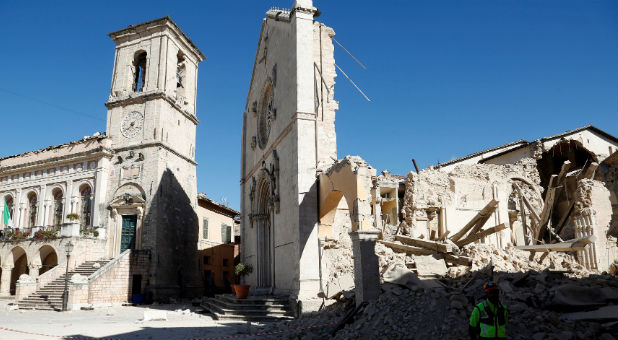Historic Earthquake Sends Clergy Fleeing for Their Lives
Sunday’s earthquake struck the medieval walled town of Norcia as nuns, monks and priests were heading to morning prayer services, giving them just enough time to flee as the walls around them plunged to the earth.
The quake hit the same central regions that have been rocked by repeated tremors over the past two months. Although it was bigger than an Aug. 24 earthquake that killed almost 300 people, no-one died on Sunday, but there was huge damage.
Weakened by repeated powerful jolts in recent weeks, many of Norcia’s churches, monasteries and chapels were wrecked.
“We thought it was the end of everything,” said 74-year-old Sister Maria Raffaella Buoso, sitting on a bench outside the walls of Norcia after being evacuated from the Monastery of the Poor Clares of Santa Maria della Pace.
The nuns of the Poor Clares are normally cloistered and only leave the monastery in an emergency. Firemen had to break the doors down to get them out.
The six nuns have been ordered to leave for now, although they are confident that their church, which was built at the beginning of the 16th century, did not suffer extensive damage.
Other places were less fortunate, including the historic Basilica of St. Benedict, which stood on the main square of Norcia and was supposedly built over the birthplace of Benedict, the patron saint of Europe, and his sister St. Scolastica.
Badly damaged in multiple quakes on Aug. 24 and Oct. 26, the monastery complex, including the 13th century Basilica, finally collapsed in a pile of rubble on Sunday, leaving just the gothic facade standing.
The 13 monks had been forced to abandon their monastery and their small commercial brewery following the previous tremors. However, they had hoped for a swift return, with the Italian emergency services releasing video earlier this week showing roof repairs being carried out on the imposing Basilica.
Although Norcia is intimately linked with Saint Benedict, the monks only came back to the town in 2000, some 190 years after the community was suppressed by the French Emperor Napoleon Bonaparte when he took control of swathes of Italy.
“(We have) started to accept once more that our life is not our own and God has altered our path once again,” one of the monks, father Benedict, wrote mid-week after the Oct. 26 quake.
With dust still blowing in the air on Sunday morning following Italy’s strongest quake since 1980, monks and residents sank to their knees in front of the eviscerated Basilica in silent prayer.
While many of Norcia’s sturdy houses have been earthquake-protected and largely survived this year’s wave of tremors, the town’s bigger religious structures were found to be less stable.
“Our churches have suffered terrible injuries,” said mayor Nicola Alemanno, describing the old stone buildings as though they were living beings.
A short distance from the town square, the Cattedrale di Santa Maria Argentea lay in ruins, its roof caved in, while the nearby Convent of Sant’Antonio was also badly scarred.
“Everything is broken. All the rooms, the belltower has fallen down, the church itself,” said an elderly nun, leaning on her cane as she was interviewed by la Repubblica TV.
Local authorities have ordered residents out of the town center, forcing the nuns and monks to seek shelter elsewhere, including the six sisters from the Monastery of the Poor Clares, who were dismayed to hear that they would have to stay with Benedictine nuns in nearby Trevi.
“They live differently in other cloisters. They don’t get up to pray at night,” said Sister Maria Chiara Vittorie, 73.
“It makes me sad to leave because this is our cloister, our life is here.” {eoa}
© 2016 Thomson Reuters. All rights reserved.














































